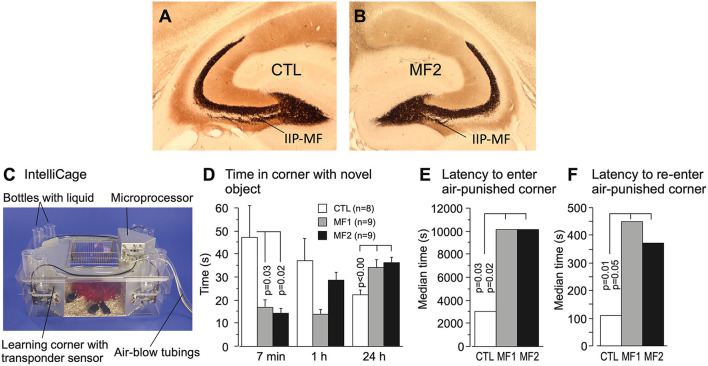Figure 6.
Natural selection of the hippocampal mossy fiber distribution in laboratory mice exposed to semi-naturalistic environments in Russia (Lipp and Wolfer, 2013) and behavioral changes in later generations raised in the laboratory and tested in a home-cage system. (A) Mice raised in parallel to the feralized animals but living in an animal house showed relatively large intra/infrapyramidal mossy fiber projections (IIP-MF) synapsing on basal dendrites. For details see Figure 5. (B) The feralized mice showed a significantly reduced IIP-MF projection and reduced exploratory activities in standard tests that persisted after embryo transfer in Switzerland. (C) Automated homecage system (IntelliCageTM) used for testing non-handled mice living in social groups (Kiryk et al., 2020). Mice carry transponders recording visits and water consumption in corners permitting operant conditioning but also assessing spontaneous reactions. (D) For this test, a novel object (a nut) was placed in one of the familiar corners for measuring the novelty reaction. Note that during the first 7 min the descendants of the naturally selected mice did not enter that corner much, while the control lab mice appeared very interested but lost interest thereafter, while the MF1 and MF2 were inspecting that corner more after 24 h. (E) The experiment started with randomly released and noisy air puffs in the corners, disturbing the mice. Control animals took about 1 hour to enter any one of the corners after which they received an air puff, while the MF1 and MF2 mice took many hours. (F) The CTL mice re-entered the corner in which they had received punishment significantly faster than the MF1 and MF 2. Except for some preliminary data, most of the results have not been published. The IntelliCage experiment was designed and conducted by Ewelyna Knapska, Warsaw.

